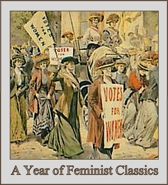Reviewed by Connie
Published: 2000
It's about: This historical account of the "flappers" of 1920s America examines women's "performances" of the era -- their fashion, hairstyles, the emergence of bathing beauty competitions, and the popularity of burlesque shows -- in order to expose the embedded contradictions of this glamorous period. Louise Rosine, for example, is arrested for wearing a one-piece bathing suit to the beach and not wearing stockings to her knees, but bathing beauty competitions parade one-piece bathers for all the world to see and crown them queens. Furthermore, the new, revealing fashions of the time that abandoned the corsets and ankle-length hoop skirts of the Victorian Age prove to be a liberating force for women while at the same time contributing to the commodification and sexualization of the female body.
I thought: As my own sense of feminism has grown over the past few years, I have taken every opportunity possible to learn more not only about what it means to be a woman in the world of today but what is has meant to be a woman in the past and how we got to the point where we are. When I picked up this book, I knew little more about the "flappers" than I had gleaned from photographs and your regular ol' F. Scott Fitzgerald novel. This book, however, opened my eyes and shed light on an era rife with contradictions, complicating the notion of a flapper so that I still am not quite sure if they advanced the female cause or inhibited it. Frankly, that's probably a good thing, as the movement likely did both.
The book is not only historical accurate about a complex era, but it is also a surprisingly enjoyable read. Latham begins her book with the anecdote of her grandmother, who continued working as a school teacher in the 20s after she married (women were expected to quit after marriage) and who had bobbed her hair but pinned on her long braid every day for work (a bobbed haircut was grounds for dismissal). Already, this book had my interest.
As Latham focuses on the "performances" of the era through an ethnographic approach, she includes plenty of primary sources from newspapers and personal accounts, photographs of women getting arrested off the beach, illustrations from period magazines, and humorous and enlightening anecdotes to give the book a leisurely feel. This is no history textbook, ladies and gents.
Verdict: Stick this on the shelf
Reading Recommendations: Well, if the topic itself doesn't interest you, I probably wouldn't bother. But if you've always wanted to know more about the flapper era, I definitely recommend this book.
Warnings: Obviously, issues of nudity are addressed in the book, but there's nothing explicit here.
Favorite excerpts: My favorite part of this book was the anecdote about Louise Rosine, the 39-year-old, heavily-built "immodest bather" who was imprisoned for her outfit:
"According to the 'blushing warden,' Wes Brubaker, Rosine, once in jail, disrobed entirely and announced her intention to remain undressed until she was freed. Although hunger strikes had been attempted under his authority, the warden was unprepared to deal with this form of rebellion. He finally called upon the assistance of two female inmates whom he instructed to pin blankets around Rosine's cell to shield her from view."
Thursday, July 22, 2010
Posing a Threat: Flappers, Chorus Girls, and Other Brazen Performers by Angela Latham
2010-07-22T16:43:00-04:00
MedSchoolWife
Book Reviews|Connie|Historical Non-Fiction|On the Shelf|Women's Studies|








